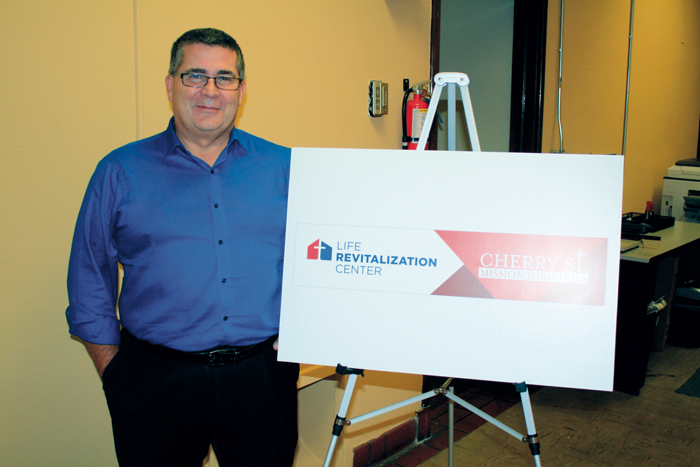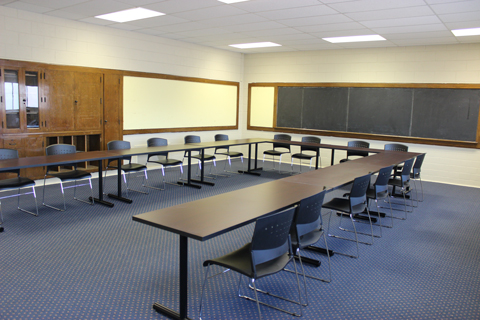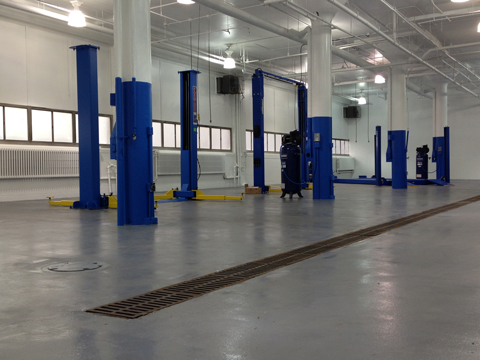
As published in the December 1, 2015 Toledo Business Journal

Dan Rogers
Cherry Street Mission Ministries
Cherry Street Mission to provide vocational training
Dan Rogers, the president and CEO of Cherry Street Mission Ministries, shares a vision for Toledo that includes renovating the old Macomber building and repurposing it for adult vocational training. The Toledo Business Journal met with Rogers to find out more about his organization’s plans involving vocational training.
Toledo Business Journal: Cherry Street Mission will soon offer forklift training. What is the timing of this new training program and who will be included?
Dan Rogers: We’re on the threshold now of opening several schools, and one of them is both a forklift school and a Commercial Driver’s License (CDL) school. The forklift school is set to open mid-November, and it’s open for everybody. As a matter of fact, everything about this project is open to the entire community, because this project at Cherry Street has always been about both homelessness and poverty. We’re the largest organization in about 18 counties that leads that charge in both those fields. So this project, in its maturity, is far more about reversing poverty than it is about anything else.
TBJ: Can you discuss your plans for a vocational training school in terms of the impact on area homelessness?
DR: The plan is to build this bridge that doesn’t presently exist. The bridge that I’m talking about are the homeless underemployed and unemployed of our community who are largely in the central city and don’t have a clear bridge to go across to go home.
Homelessness isn’t really about a house, contrary to popular belief. If that were the case we would call it houselessness, but it’s not, it’s actually homelessness. Home isn’t about an address, home is the sense of the thing we say when we come back from a long trip and say, “It’s good to be home.” We know we’re not talking about the address or the tap water or the carpet, we’re talking about the sense of belonging. When you live in poverty, particularly if you live in generational poverty, there’s no sense of home in poverty. No one ever comes home and says, “It’s good to be home.” What we do hear is that it’s good to have a lock on our door. But there’s no real sense of home in poverty. That’s why poverty and impoverished neighborhoods are the feeder neighborhoods of homelessness.
The reality is, when we think about how this school operates, this school is about building a bridge to home, and to rebuild neighborhoods by connecting people to well-paying jobs. The process of this school is we started with industry leaders, we actually didn’t start with the vocational partners. In 2015 we dedicated the entire year to understanding the industry need, and then invited the industry leaders into the project itself. Then we brought in vocational partners that are going to meet the needs that employers have rather than the other way around.

TBJ: Can you provide an update on your organization’s effort with the former Macomber building and the extent of renovations?
DR: If you buy a building in 2013 that was built in 1932, you’ve bitten off quite a bit. So we’ve been able through our community to cash flow about a million and a half into this project already. That’s included a new parking lot, roof system, heating systems, restrooms. We have stabilized the envelope and the interior of the building. The cool thing that this building yields is that, as a WPA project, it was built exceptionally well. Engineers just can’t believe how well built and how the mechanicals of this building were built very thoughtfully. So while it’s going to take a chunk to renovate and update, this building is in remarkable shape.
This building will be used for 100% adult vocational training. The beauty about vocational training in the central city is that there isn’t any. The only vocational training for adults in the central city is TPS. TPS has two adult schools, one is a barber school and one is an LPN school. Romules Durant, who is such a vital part of this city and this region, is one of our vocational partners. Every other vocational school that we’re working with is expanding as a business model into this project. So what this does is give vocational schools like Penta, Owens, and Northwest State Community College, which are our other three vocational partners, it gives them an opportunity to expand their reach to a population that they don’t have access to. TPS has taken a different approach, so instead of expanding their school, they are moving their school. So we’re now working with Romules and his team over the last year and a half, to actually pick up their two adult schools out of Devilbiss and move them here. And that way by the time this project is done, which I believe will be by the end of 2016, we will likely have more than 12 full adult vocational schools operating in this facility.
TBJ: What do you see as the amount of capital funds needed for this facility and where do fundraising efforts stand with this?
DR: We are using the normal historical funding mechanisms, but we believe we will be top end about $8 million. When we started, the engineers told us it was going to be $18 million. But as you get into the project you realize that you can take a top end number and bring that lower because you understand the building better, and because the project itself matures in terms of what you’re going to be using the building for, and lastly because of how companies and organizations sometimes make in-kind gifts. That really lowers the cost, so we think about $8 million will be the amount of total funding needed.
TBJ: Can you discuss the mission of your organization and how your efforts with vocational training fit Cherry Street Mission’s purpose?
DR: Our purpose is to provide purposeful discipleship to all those who come to us in need. The beauty of this project is that we offer something to vocational schools and something to businesses that they couldn’t offer themselves. We actually offer them the spiritual, and the soul, and the relational component that they’re not really in the business to do. So, while I’m not in the business to educate or to job place, I’m in the business of making sure that someone spiritually just knows how to tie their shoes. Like, “Can you stand upright and be an upright citizen? That’s the work of Cherry Street. Vocational schools and employers will work with students and employees to get them there, but that’s not really their task. Just like I have job placed and I’ve educated, but that’s more secondary and tertiary to my original mission.
What this project affords is a marriage of platforms that, under a single roof, an individual gets it all. Under a single roof they get their relationship issues in order. It’s not that you’re unable to turn the wrench or answer the phone or do the thing that you are qualified to do, no, something is happening to you relationally that you keep getting in trouble about, something is happening to you spiritually that you are confused about, or something is going on inside of your soul, or maybe you had a past addiction and have had long lapses of sobriety, and suddenly that’s troubling you again. So it’s not your skill-set or lack of your skill-set that is stopping you from showing up to work on Monday, it is something far more systemic than that.
So that’s the beautiful partnership; each of us doing our primary work under a single roof, and releasing each other to do the secondary and tertiary work that others do. So that’s the beauty of this project and that’s how it fits into Cherry Street.
TBJ: Can you discuss some of the other programs that you offer to address the issue of the homeless in our area including your shelter activities and food distribution?
DR: Cherry Street has always been deep in drug and alcohol recovery. We provide education: GED, WorkKeys training, read for literacy, are all the things that we do.
Advocacy is very important to us here at Cherry Street, people just need someone to stand with them. We advocate all the time, I can’t tell you how many times one of the men or women in our care has gotten arrested or the US marshals have come looking for them. We’re not the US embassy so we don’t provide anybody sanctuary, but what we do do is that we go with them and we stand in front of the judge and ask if there is a way we can mitigate this through programming. Usually both attorneys and the judicial system as a whole, would much rather have them in the community getting better rather than have them incarcerated. As a matter of fact they will tie their incarceration to whether they complete our program or not.

TBJ: What are the number of people that you serve in your current facilities, and what is a typical level of utilization?
DR: About 425 men, women, and children will come through our doors every 24 hours, and that’s seven days a week. We’re the only organization in 18 counties that actually runs and is open to everybody 24 hours a day, seven days a week, there are no days off here. As a result of that, Cherry Street serves 56% of the homeless population in northwest Ohio. We’re at about 1,000 meals a day, we have 330 beds presently, we’re at about 80% and we’ll be at about 110% capacity by February, which is normal and standard.
TBJ: Can you also discuss your program and facilities for women – Sparrow’s Nest?
DR: Sparrow’s Nest opened in ’94 or ’95. The First Roots of God pastor Bob Culp actually opened the Sparrow’s Nest a year and a half or two years prior because they really felt they needed to be in the women’s ministries business, but then they realized that running a house is very difficult. You have to operate it 24 hours a day, seven days a week, there is no turning your back once you start serving the community. They quickly turned to Cherry Street right about mid-1990s and asked if we would take this over and we did.
We also have eight family units. We got into family housing about four years ago as a result of more and more families showing up in the middle of the night, which used to be an anomaly, and right about ’09 or ’10 it started becoming more of a trend where half a dozen families a year would show up at like 3 o’clock in the morning. So because there was no real answer for them in an immediate crisis, we opened up family houses. We now operate what’s called supported transitional housing for families. One of our key partners in that is Family House, which is the largest shelter for intact families in northwest Ohio. As a matter of fact, it is the second largest in the state of Ohio. They are like a feeder organization to our family houses.
TBJ: How can area businesses benefit from the vocational training that Cherry Street Mission will be providing and what opportunities are there for area firms to support your efforts?
DR: The benefit is all the employers everyday that say they cannot find skilled labor, they get an answer for that now. The way that I’ve fashioned this entire process is I’ve asked businesses to do three things.
Number one is inform us on the curriculum, and that’s a very important thing because if we classically train vocational career and tech training but it doesn’t really match what you need, I’m not entirely sure how we’re helping you.
Number two, equally important, is to inform us on the culture. What kind of culture needs to be here so that they are successful in your culture?
So my concern is I’ve researched vocational schools both for high school and adult, and the educational world is a fairly scrubbed, sanitized world. And adult education seems to follow that same high school trend. I’ve seen the culture of adult education, and adult vocational training specifically, be very sanitized and very academic, but that’s not really industry culture.
Thirdly, there’s an investment opportunity, and those opportunities fall in two succinct ways.
Number one is a human investment, because every business in essence runs their own vocational school called on-the-job training. They’re running this training but they’re really poor at it. Not for lack of trying, but because they hire people to work. They have a two or three-day process where they explain the job, and so they’ve created floor managers and supervisors and foremen and HR directors as essentially adjunct professors running their internal vocational school. I’ve asked them to invest the people who are already running their vocational schools, by investing them once a week, once a month, or once a quarter, so that they can support our curriculum and support our culture, and – more importantly – they can build a bridge of relationship that presently our HR department doesn’t have. That’s the enormous benefit back to the company is they get to participate in something that is relationally based.
The second level of investment is capital investment. I like money, but I like money to show up last. I think one of the problems we face in society is we throw money at things first, which is funny because the business world doesn’t really operate that way. I think that the first investment has to be human. Once humans are involved, then humans can step back and say money is needed, but almost always it’s less. I’ve proven this again and again and again, that we’ll need less capital if the humans get involved first.
TBJ: Are there any other issues that you would like to address?
DR: KeyBank invited us to come in, take a thoughtful walk through furniture in their former building that they wanted to donate, and gave us an opportunity to tag it, and then they looked at what everybody had tagged to make a decision about what they are able to honor. And then we picked it up, and it’s all going to be used to equip a lot of this building.
So you look at the $18 million that the engineers say, but then who knows how many thousands of dollars KeyBank took off of our building project.